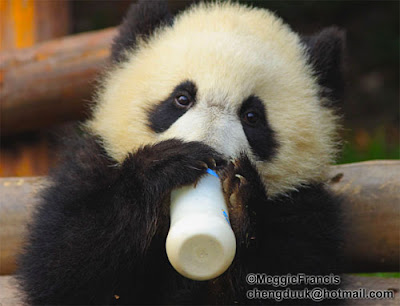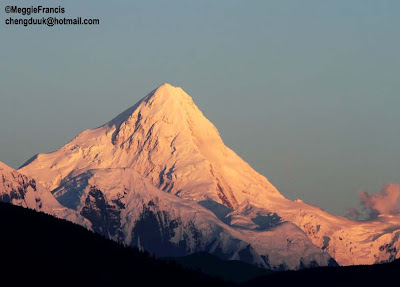 The boats from Leshan lining up to slowly sail by the Big Buddha
The boats from Leshan lining up to slowly sail by the Big BuddhaCurrently there are two ways of viewing the Big Buddha at Leshan - going into the Buddha site and walking the stairways around the monument or taking a boat, from the town side of the river, and viewing him from the water. One of our old posts reported on a third choice - the island vantage point that cost just 1RMB - but some mean spirited persons have built a big fence that now prevents this fun option.
Price wise there isn't much between boats and buying the park ticket - the boats costs 70RMB and the getting into the Buddha site 90RMB. However the boats and the park gate being on opposite banks are at least 20 minutes drive from one another.
 The boats sails very close into the Buddha
The boats sails very close into the BuddhaThe biggest differences with the two methods of viewing are - quality of view, time span, and convenience.
When sailing you're close enough to see all the details - but far enough away to easily see the monument in its total entirety the - the boat gives the best panoramic views.
 The guardian statues that flank Big Buddha can only be seen from the river
The guardian statues that flank Big Buddha can only be seen from the riverSailing past the cliff face you'll be able see many features that are invisible to those viewing from within the park.
However the whole experience is very short - the whole boat ride only takes about 20 minutes with around 10 minutes directly in front of the Buddha. Although useful if you're fighting through a packed itinerary, and also have plans for Emei on the same day - those who were just planning on a Buddha visit could feel a 3 hour+ drive all the way from Chengdu is lot of bother for a few minutes of sailing time!!!
In contrast, taking into the park allows you to spend hours rather than minutes at this site.
 Queues inside the park - steep stairways and a crowd
Queues inside the park - steep stairways and a crowdInside the park you can find yourself staying a little longer then anticipated. On busy days - weekends and holidays - Big Buddha can be rather crowded out. We've seen some pretty nasty human bottlenecks forming on the steep stairways that runs around the monument. In extreme circumstances I've read of folk being stuck for 2 hours in one of these jams.
 However week days out of high season can be far quieter - but the picture shows how steep the stairs are. Not recommended for those who suffer from Vertigo.
However week days out of high season can be far quieter - but the picture shows how steep the stairs are. Not recommended for those who suffer from Vertigo. But if you want to get real close to the Buddha - the only option is going into the park.
But if you want to get real close to the Buddha - the only option is going into the park.Inside the park there's an ancient Pagoda and exhibits/educational information on the history and the construction of the Buddha. The boat provides none of this - it's merely a sight-seeing service.
 And here's a photo of the Buddha from the boat
And here's a photo of the Buddha from the boat And one from the park - with a wide-angle lens.
And one from the park - with a wide-angle lens.One other point to note - watch out for the folk who want to take your photograph on the boat. They offer - in a rather 'assertive' way - a service where they will print the picture when you return to shore. For a couple of our guests they took and printed more pictures than they wanted - you then have to wait around 15 minutes for the finished pic - and the pics cost, after some bargaining, a rather expensive 60RMB each.















































